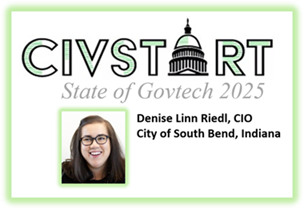
Transforming Cities Through Technology and Collaboration: Ten Insights from My Conversation with Denise Linn Riedl, South Bend’s Chief Innovation Officer

As the host of The Business of Government Hour, I recently interviewed Denise Linn Riedl, Chief Innovation Officer for the City of South Bend, Indiana, at CivStart’s State of GovTech 2025. Our conversation explored how technology and innovation are reshaping the relationship between cities and residents, transforming governance, and advancing the govtech ecosystem. In this essay, I present ten insights from our discussion, highlighting key strategies and themes for leveraging technology to enhance municipal service delivery and resident engagement.
1. A Resident-Centric Vision Anchors Innovation
Denise’s role as Chief Innovation Officer is multifaceted, encompassing core IT services, digital platforms, data analytics, 311 customer service, and civic innovation initiatives like research and development and university partnerships. She likened her team to a “Swiss Army knife,” reflecting the versatility required in smaller cities with limited resources. At the core of her vision is a commitment to enhancing the resident experience. Whether a resident is starting a business, reporting a pothole, or submitting a Freedom of Information Act (FOIA) request, Denise’s team strives to make these interactions seamless, intuitive, and accessible. This vision considers the resident’s entire journey—from the moment they “roll out of bed” providing alternatives for those without home internet access and simplifying jargon-heavy processes. By focusing on usability, South Bend is redefining how cities engage with their communities, ensuring technology serves as a bridge rather than a barrier.
2. New City Hall Sparks Comprehensive Digital Transformation
The opening of a new City Hall in South Bend has served as a catalyst for both physical and digital transformation. Denise described how her team is outfitting the new facility with modern technology, including advanced meeting room equipment and enhanced security systems. However, the mayor’s challenge to ensure residents can access services without visiting City Hall prompted a parallel effort to digitize processes. This includes developing digital payment systems, online applications, and a new scheduling platform for residents to book appointments with city teams. Additionally, the city is deploying kiosks in neighborhoods to provide access points for those who prefer or need in-person alternatives. This dual focus on physical and digital experiences ensures that the city’s services are responsive, setting a model for how infrastructure projects can drive broader technological innovation.
3. Centralized Digital Services Strengthen Operations
In 2023, South Bend reorganized its Innovation and Technology Department to bolster its capacity for digital transformation. This included creating a dedicated digital services team to manage web assets and drive the digitization of forms, payments, and other processes. Concurrently, the city centralized its 311 customer service operations, creating a one-stop-shop service center on the new City Hall’s first floor. This reorganization addressed a previously decentralized approach to web management and customer service, where skills were scattered across departments. By consolidating these functions, Denise’s team has enhanced efficiency and consistency, enabling the city to deliver a more cohesive and user-friendly experience for both residents and staff. This structural shift demonstrates how organizational design can amplify technological impact.
4. Data Analytics Drives Informed Decision-Making
Data is a cornerstone of South Bend’s innovation strategy, with a dedicated data and performance team led by David Finlay, which embeds analysts within city departments to deeply understand their processes and data. For example, one analyst participated in a police department recruitment test to better interpret recruitment data, illustrating the team’s commitment to contextual expertise. This approach informs tailored performance management plans aligned with the mayor’s annual goals, such as improving customer service metrics. Monthly “data huddles” bring together department heads and middle management to review metrics like 311 call-to-digital-request ratios and utility payment automation rates. These sessions foster a shared understanding of performance, motivate teams, and empower departments to take ownership of their data, driving continuous improvement across the city.
5. Community Feedback Ensures User-Friendly Solutions
South Bend’s “listen first, build with” philosophy emphasizes the importance of resident input in shaping technology projects. A prime example is the 2020 rollout of the 311.southbendin.gov system, where Denise’s team recruited a cohort of residents for virtual user testing. This process revealed critical flaws, such as a confusing taxonomy where “report a business” was misinterpreted as reporting a missing business rather than an illegal operation. By incorporating resident feedback, the team redesigned the system to be more intuitive, preventing potential confusion and enhancing usability. This approach highlights the value of community engagement in catching issues early and ensuring that solutions resonate with those they serve.
6. Collaboration Fosters a Culture of Innovation
Denise cultivates a culture of innovation by leading with core values—kindness, resiliency, responsiveness, customer service, and cohesion—that guide hiring and shape her team’s identity as an internal service provider. Rather than taking center stage, her team amplifies the efforts of other departments, ensuring that frontline staff, such as code enforcement inspectors or parks maintenance workers, are celebrated as the face of innovation. This strategy secures buy-in and grounds solutions in the realities of frontline operations. Denise emphasized that technologists must avoid assuming they fully understand problems without consulting those closest to the work, as frontline staff often have deep insights into challenges and solutions. This collaborative approach fosters a citywide culture of innovation that is both inclusive and sustainable.
7. Strategic Partnerships Expand Innovation Capacity
South Bend leverages partnerships to enhance its innovation efforts, particularly with the University of Notre Dame and early-stage startups. Notre Dame’s data science expertise supports big-picture, non-time-sensitive projects, such as developing an ethical and operational framework for deciding when to procure services versus using in-house AI tools. This framework addresses the impact of AI on local service contracts, like those for graphic designers, blending philosophical and technical perspectives. Denise also expressed enthusiasm for working with startups, valuing their willingness to listen and adapt to city needs. By collaborating with early-stage companies, South Bend not only benefits from tailored solutions but also contributes to a stronger govtech ecosystem by encouraging startups to prioritize municipal challenges early in their development.
8. Generative AI Enhances Multilingual Accessibility
One of South Bend’s most innovative projects is a generative AI-based document translation tool designed to make city communications—flyers, reports, memos, and more—available in multiple languages. This streamlines a previously decentralized, time-consuming process, though adoption requires training and potential policy changes like a citywide language access plan.
9. Change Management is Critical to Technology Adoption
A recurring challenge in South Bend’s innovation journey is ensuring technology adoption. Denise noted that even well-designed tools, like the AI translation system, can fail to gain traction without intentional change management. Her team has become more disciplined in addressing this, embedding adoption strategies from the outset of projects. For example, after noticing that new software or digitized processes were underutilized, the team began anticipating barriers and designing training and support to overcome them. This insight underscores that technology’s success depends not only on its functionality but also on the human and organizational factors that drive its use.
10. Capacity Constraints Challenge Scalability
As a small city, South Bend faces significant capacity constraints—limited staff, time, and budget—while managing a broad portfolio that includes cybersecurity, software implementation, and data analysis. Denise’s team mitigates these challenges by adopting a versatile, “Swiss Army knife” approach, prioritizing high-impact projects and leveraging partnerships to extend their reach. However, the strain of juggling diverse responsibilities remains a hurdle, particularly when supporting multiple departmental goals. This reality highlights the need for strategic resource allocation and external collaboration to sustain innovation in resource-constrained environments.
Shaping a Better Future Through GovTech -- A Model for GovTech Transformation.
My conversation with Denise Linn Riedl underscores how technology and innovation are redefining the relationship between cities and their residents. South Bend’s resident-centric approach—prioritizing accessibility and seamless experiences—demonstrates how technology can bridge gaps and build trust. By leveraging tools like AI, data analytics, and digital platforms, the city is making governance more responsive and efficient, while partnerships with universities and startups are expanding its capacity to innovate.
At the same time, Denise’s insights highlight the importance of human-centered strategies in govtech. Technology is a powerful enabler, but its success depends on collaboration, community input, and robust change management. As the govtech ecosystem continues to evolve, cities like South Bend are showing how innovation can transform governance to create a more accessible and responsive future putting residents first and fostering a culture of innovation that empowers both city staff and the community they serve.



